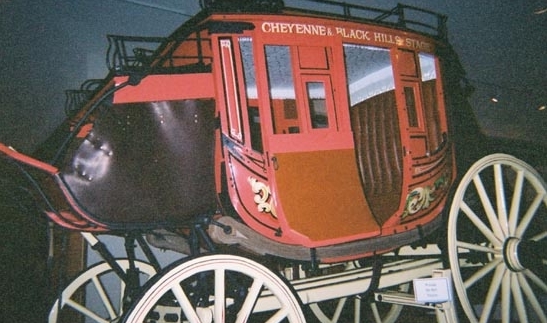
Deadwood Stage, Buffalo Bill Museum, Cody. Photo
by Geoff Dobson.
The line used both smaller coaches drawn by four
horses and larger
18-passenger coaches pulled by six horses. The
drivers often in arriving at their final destination
would make "a show of it", thundering into town with the red or yellow Concord
coaches "licky-cut", pulled by a matched team of six horses.
With the stages carrying gold, the danger from road agents was always present, indeed,
to such an extent that the line used a ironclad coach named the "Monitor" for
transporting gold. The coach, specially constructed in Cheyenne, was lined with iron plate with a
"treasure box" bolted to the floor on the inside. According to Scott Davis, one of the Company's
messengers, the treasure box was guaranteed by its manufacturer to be able to withstand assaults upon it for twenty-four hours.
At the 1914 Wyoming State Fair, he explained: "It was not supposed that a gang of robbers running around through the
mountains could get into the safe within the guaranteed time." As quoted in "The Story of the Cheyenne-Deadwood Treasure Coach Hold-up at
Cold Springs, Wyoming. September 29th, 1878," Proceedings and
Collections of the Wyoming State Historical Department, 1919-1920, p. 125.
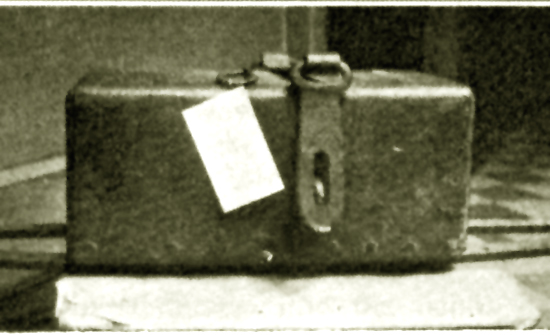
The Monitor's "Treasure Box."
Regular passengers were not permitted and extra guards
known as "messengers" would be on board. Among those who were employed at various times as
messengers were D. Boone May, discussed below, and Wyatt Earp. The Monitor, itself, was held up by road agents on September 26, 1878,
at the Canyon Springs Station. The coach was driven by Gene Barnett with Galen "Gale"
Hill riding "shotgun" next to the driver. Inside were messengers Scott Davis and Eugene Smith and company
telegraph operator H. O. Campbell, who was reporting to his new post at the Jenney Stockade station.
When the coach pulled into the station, no one was to be seen. Normally as a coach nears a station, the
driver would blow for the horses. The station attendant, in this case, William Miner, would have
a fresh team out and ready. For more on blowing horses see Overland Stage.
Barnett and Hill alit from the box, with Barnett going to look for Miner and Hill chocking the
rear wheels of the coach. Shots rang out. Hill was wounded, Campbell killed and Davis lit out for the
woods. The road agents
had little difficulty in breaking open the supposedly impregnable safe used for
carrying the gold.
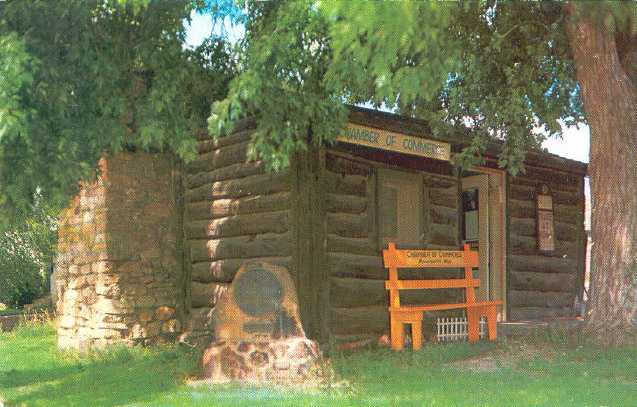
Modern view of Jenney Stockade stage station
Meanwhile at the Jenney Stockade station, three relief messengers, Boone May, Jesse Brown, and Bill Sample, awaited the arrival of the
coach. When it did not appear, the three rode north and eventually came across Davis riding south for help on a horse he
had borrowed at a neighboring ranch. The four then proceeded to the Canyon Springs Station where they
found the coach abandoned with the treasure box empty, Miner locked in the
granary, the relief team stolen, and other employees bound and gagged tied to
trees in the woods. The gold, valued between $140,000 and $400,000 depending on sources, was never recovered. Note:
Davis contended that much of it was recovered later.
Hill died several years later from complications from his wounds.

Canyon Springs Station
Later that year, William Mansfield and Archie McLaughlin attempted to sell stolen
bullion in Deadwood City. They were taken to Cheyenne for trial, but on the way the
coach was stopped by masked men who extracted a confession by threat of a rope. In Cheyenne,
trial was delayed and the prisoners were taken back to Deadwood City. On the way, masked
men again held up the stage near Cheyenne Crossing, removed the prisoners and hanged them leaving their
bodies to be removed by a passing troop of soldiers.
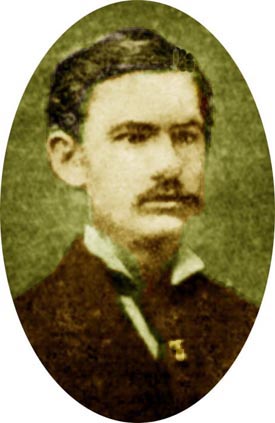 Galen Hill Galen Hill
Nor was that the only time prisoners were removed from the stage to insure that they met their
Maker. In October 1878, the rustler, Cornelius "Lame Johnny" Donahue, was being returned from Chadron to Rapid City
by James L. "Hawkbeak" Smith, more commonly referred to as "Whispering Smith." The nickname "Hawkbeak" was not one
to be used to Smith's face. The name came from the shape and size of his probiscus. Smith was
described by Edgar Beecher Bronson in his 1910 The Red-Blooded Heroes of the Frontier:
A type diametrically opposite to that of the debonair Boone May was
Captain Jim Smith, one of the best peaceofficers the frontier ever
knew. Of Captain Smith's early history nothing was known, except that
he had served with great credit as a captain of artillery in the Union
Army. He first appeared on the U. P. during construction days in the
late sixties. Serving in various capacities as railroad detective,
marshal, stock inspector, and the like, for eighteen years Captain
Smith wrote more red history with his pistol (barring May's work on the
Sioux) than any two men of his time.
The last I knew of him he had enough dead outlaws to his
credit--thirty-odd--to start, if not a respectable, at least, a
fair-sized graveyard. Captain Jim's mere look was almost enough to
still the heart-beat and paralyze the pistol hand of any but the
wildest of them all. His great burning black eyes, glowering deadly
menace from cavernous sockets of extraordinary depth, were set in a
colossal grim face; his straight, thin-lipped mouth never showed teeth;
his heavy, tight-curling black moustache and stiff black imperial
always had the appearance of holding the under lip closely glued to the
upper. In years of intimacy, I never once saw on his lips the faintest
hint of a smile. He had tremendous breadth of shoulders and depth of
chest; he was big-boned, lean-loined, quick and furtive of movement as
a panther. In short, Captain Jim was altogether the most
fearsome-looking man I ever saw, the very incarnation of a relentless,
inexorable, indomitable, avenging Nemesis.
Like most men lacking humor, Captain Jim was devoid of vices; like all
men lacking sentiment, he cultivated no intimacies. Throughout those
years loved nothing, animate or inanimate, but his guns--the full
length "45" that nestled in its breast scabbard next his heart, and the
short "45," sawed off two inches in front of the cylinder, that he
always carried in a deep side-pocket of his long sack coat. This was
often a much patched pocket, for Jim was a notable economist of time,
and usually fired from within the pocket. That he loved those guns I
know, for often have I seen him fondle them as tenderly as a mother her
first-born.
Boone May was the
messenger and Jesse Brian was the guard. Donahue, unlike most outlaws of the west, was college
educated (Girard College, Philadelphia) but got into trouble in Texas for rustling. He changed his name and moved to
the Black Hills. Unfortunately he was recognized. Thus, Donahue returned to his former profession.
At Buffalo Gap for some unexplained reason, May and Brian left the stage. Shortly thereafter two
unidentified masked men stopped the stage and removed Donahue. The stage then proceeded on.
Still in shackles, Donahue was hanged from an
elm tree near present-day Lame Johnny Creek, a tributary of the Cheyenne. The next day, some
bullwhackers found the body and gave it a burial. A small headboard was erected. In some sense there is
a pun in the wording of the grave marker. Donahue was noted for having a large mouth. Lame Johnny's
epitaph:
"Stranger pass gently o'er this sod,
If he opens his mouth, you're gone, by God."
For more on Whispering Smith see, The Wild Bunch.
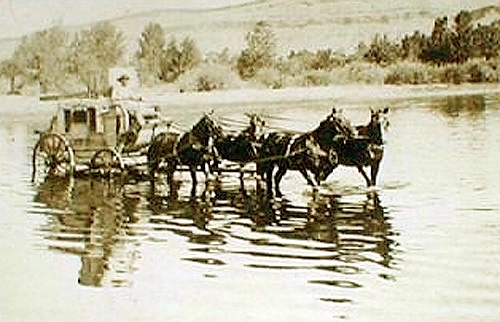
Deadwood Stage crossing the Cheyenne, undated
An additional armored stage known as
"Old Ironsides" was also used for a three-year period on the Deadwood-Sidney run and was robbed only once.
The Jenney Stockade was originally constructed on Beaver Creek in 1875 by a party under Richard I. Dodge and
Professor Walter Jenney who were exploring the Black Hills. The stockade was on the site of
a corral constructed by G. K. Warren. In 1877 it became a stage station at one end of a
night run between it and the Hat Creek Station. Subsequently, the structure was moved to
Newcastle where it is now part of a museum.
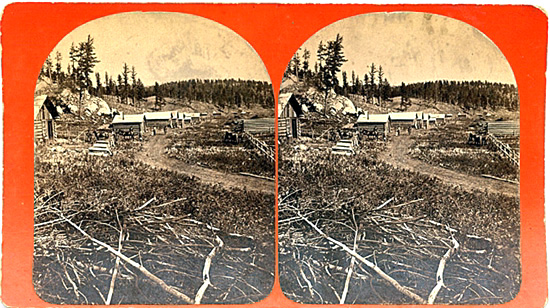
Hill City, Dakota Territory, approx. 1878. Stereograph by
Justus Fey.
Justus Fey was born in Hesse, in present day Germany. By 1878, he had established
a photography studeo in Deadwood City. He also worked as a machinist.
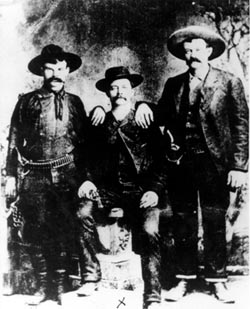
The Bass Gang, L. to R. Bass, Collins and (possibly) Murphy. See text below.
During one two-month period the Deadwood stage was held up four times by the Sam Bass Gang, consisting of
Bass, Joel Collins, Tom Nixon, Bill Heffridge and Jim Berry.
The first driver killed was Johnny Slaughter on March 25, 1877, driving a stage
bearing eleven passengers and $15,000. The stage was delayed by spring snow and
mud and a breakdown five miles north of Hill City. Two miles outside of
Deadwood road agents led by Sam Bass attempted to rob the stage a fifth time.
In the process
Slaughter was killed, the horses bolted, running off toward town only to be
stopped when the lead horses became entangled in the leads.
Slaughter's body was returned by special
coach to Cheyenne, where his hearse
was drawn by six dappled grays matching the team he had driven in Deadwood.
The gang fled to Nebraska where they robbed the Union Pacific train at Big Spring
of $60,000 in freshly minted double eagles from the San Fransisco Mint, $450.00
from the mail car safe and $1,300.00 from the passengers. Following the robbery
Collins and Heffridge were killed by a sheriff's posse near Buffalo Station, with
$25,000 being recovered.
Berry was captured at Mexico, Missouri and Nixon disappeared carrying, according
to Berry, $10,000, never to be seen again. Another alleged member of the Bass Gang,
Frank K. Towle, was killed later the same year while attempting to rob the stage.
One of the guards on the stage, Boone May, upon his return to Cheyenne discovered that there
was a price upon Towle's head. May then returned to the scene of the attempted
crime, found Towle's remains, cut off the head, and returned with his gory proof to Cheyenne
in order to collect the reward. Unfortunately, word had already gotten out about
Towle's demise and the reward had been cancelled. Thus, May's trip was for naught and
all he had for his efforts was a rather unusual souvenir. Ultimately, May disposed of
Towle's head by burying it outside of Cheyenne. It was dug up by prairie dogs who used it as
a toy.
Sixteen months after the killing of Slaughter, Bass was ambushed at Round Rock, Texas, by
Texas Rangers
to whom Bass was betrayed by Jim Murphy, a member of his gang. A compatriot,
Frank Jackson, escaped with an indeterminate amount of gold coin, which Bass had
being carrying in his saddlebags. Two days later on his 27th
birthday, July 27, 1878, Bass died from gunshot wounds
received in the ambush, his last words, "The world is bobbing around."
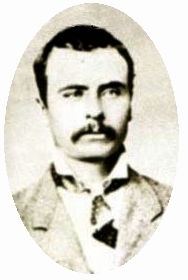
D. Boone May
It has been written of May, reputedly the "fastest gun
in the Dakotas," that "his corpses were invariably those of undesireable citizens, never
of the law abiding." In at least one instance a jury believed that the corpse was of an
undesireable, Curly Grimes, so called for his dark, shoulder length locks. May and William H. H. Llewellyn, a government agent had
taken Grimes, a suspected road agent into custody. Grimes' body was found frozen in
the snow near Hogan's Ranch. When tried for the murder of Grimes, the jury believed
Llewellyn and May's version that Grimes had attempted to escape and found the two "not guilty."
May ultimately, himself, became a fugitive from justice and disappeared, allegedly to South
America where, according Ambrose Bierce, he died of yellow fever.
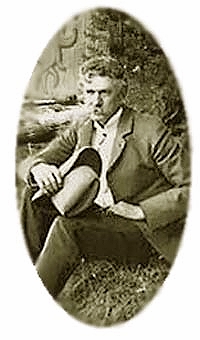
Ambrose Bierce
Bierce, later to gain fame as an author and as a result of his unexplained disappearance, managed the
Black Hills Placer Mining Co., 1879-1880. The company organized in 1879 and capitalized at $10,000,000.00
constructed a twenty-mile long, $2,000,000 flume for its mining operation.
In his A Sole Survivor Bierce
wrote of May:
One night in the summer of 1880 I was driving in a light wagon through the
wildest part of the Black Hills in South Dakota. I had left Deadwood and was
well on my way to Rockerville with thirty thousand dollars on my person,
belonging to a mining company of which I was the general manager.
Naturally, I had taken the precaution to telegraph my secretary at
Rockerville to meet me at Rapid City, then a small town, on another route;
the telegram was intended to mislead the “gentlemen of the road” whom
I knew to be watching my movements, and who might possibly have a
confederate in the telegraph office. Beside me on the seat of the wagon sat
Boone May.
Permit me to explain the situation. Several months before, it had been the
custom to send a “treasure-coach” twice a week from Deadwood to Sidney,
Nebraska. Also, it had been the custom to have this coach captured and
plundered by “road agents.” So intolerable had this practice become—even
iron-clad coaches loopholed for rifles proving a vain device—that the mine
owners had adopted the more practicable plan of importing from California a
half-dozen of the most famous “shotgun messengers” of Wells, Fargo &
Co.—fearless and trusty fellows with an instinct for killing, a readiness
of resource that was an intuition, and a sense of direction that put
a shot where it would do the most good more accurately than the most
careful aim. Their feats of marksmanship were so incredible that seeing was
scarcely believing.
In a few weeks these chaps had put the road agents out of business and out
of life, for they attacked them wherever found. One sunny Sunday morning
two of them strolling down a street of Deadwood recognized five or six of
the rascals, ran back to their hotel for their rifles, and returning killed
them all!
Boone May was one of these avengers. When I employed him, as a messenger,
he was under indictment for murder. He had trailed a “road agent” across,
the Bad Lands for hundreds of miles, brought him back to within a few miles
of Deadwood and picketed him out for the night. The desperate man, tied as
he was, had attempted to escape, and May found it expedient to shoot and
bury him. The grave by the roadside is perhaps still pointed out to the
curious. May gave himself up, was formally charged with murder, released on
his own recognizance, and I had to give him leave of absence to go to court
and be acquitted. Some of the New York directors of my company having been
good enough to signify their disapproval of my action in employing “such a
man,” I could do no less than make some recognition of their dissent, and
thenceforth he was borne upon the pay-rolls as “Boone May, Murderer.” Now
let me get back to my story.
I knew the road fairly well, for I had previously traveled it by night, on
horseback, my pockets bulging with currency and my free hand holding a
cocked revolver the entire distance of fifty miles. To make the journey by
wagon with a companion was luxury. Still, the drizzle of rain was
uncomfortable. May sat hunched up beside me, a rubber poncho over his
shoulders and a Winchester rifle in its leathern case between his knees.
I thought him a trifle off his guard, but said nothing. The road, barely
visible, was rocky, the wagon rattled, and alongside ran a roaring stream.
Suddenly we heard through it all the clinking of a horse’s shoes directly
behind, and simultaneously the short, sharp words of authority: “Throw up
your hands!”
With an involuntary jerk at the reins I brought my team to its haunches
and reached for my revolver. Quite needless: with the quickest movement
that I had ever seen in anything but a cat—almost before the words were out
of the horseman’s mouth—May had thrown himself backward across the
back of the seat, face upward, and the muzzle of his rifle was within a
yard of the fellow’s breast! What further occurred among the three of us
there in the gloom of the forest has, I fancy, never been accurately
related.
Boone May is long dead of yellow fever in Brazil, and I am the Sole
Survivor.
May, in addition to being a messenger for the line, also operated the Robbers Roost Station. His brother Jim was the station attendant at the
May's Road Ranch station. May was born in Missouri in 1852. The date of his death is somewhat in question. William N. Hockett in his
Boone May — Gunfighter of the Black Hills states that May died in Rio de Janero in 1910. However, Bierce's
reference quoted above was published as a part of his Complete Works in 1909. The article was
apparently a newpaper column which had been published earlier.
Some men instinctively feared Boone May. One early diarist, Rolf Johnson,
wrote of coming across May in advance of the Sidney Stage,
[H]is eyes were a peculiar feature, being of an
indescribable hue between yellow, green, and grey, and
had a curious restless look about them. He was a man
I would instinctively fear without knowing who he was. Johnson, Rolf,
Happy As a Big Sunflower: Adventures in the West, 1875-1880,
Bison Books, 2000.
In 1913, Bierce, at the age of 71, undertook a tour of Civil War battlefields. In December of
that year, he was in Texas. Several letters to his neice suggest that it was his intent to go into Mexico which was then in
the throes of a revolution. On December 26, 1913, he wrote a letter from Chihuahua City. He was never heard from again. There is no
agreement as to Bierce's fate. The sole clue as to his intentions and where he planned to travel was the letter which, unfortunately,
has been destroyed with no copies being made. Some have indicated that the letter was to his long time
secretary, Carrie Christiansen, and that the letter revealed a plan to travel to Ojinaga, Mexico. Others indicate that the letter indicated
that his destination in Mexico was "unknown." Nor is there agreement as to whom the letter was addressed. Some writers have
indicated that the letter was to his neice Lora Bierce. In fact, there were several earlier
letters to his neice. In one, he wrote,
"Goodbye. If you hear of my being stood up against a Mexican stone
wall and shot to rags please know that I think that a pretty good way to
depart this life. It beats old age, disease, or falling down the cellar
stars. To be a gringo in Mexico -- ah, that is euthanasia."
Various writers have speculated that Bierce was killed in the seige of Ojinaga on January 11, 1914; that he was
executed by Pancho Villa; that he was suspected by being a spy and killed by federalistas in
Sierra Mojada; that he returned ill to Texas and died at Marfa, Texas; or
that the Mexico adventure was a ploy to conceal his intended suicide in the Grand Canyon. Other cite rumors that Bierce, notwithstanding that he would be
over 160 years old, is still wandering about the Sierra Madres. About the only theory that has not
been put forth, would be one that he ran away with Etta Place. Thus, Bierce achieved immortality by disappearing without
explanation into the pages of history.
Next page: Deadwood Stage Continued.
|